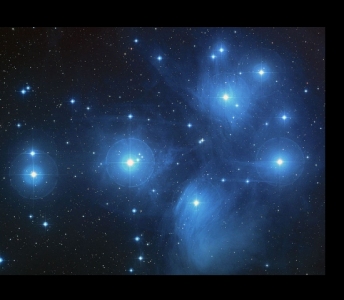
In Star Trek, a galactic cluster is a grouping of stars
formed from the same molecular cloud and bound together through
gravitational attraction. The Borg used this term for designating
certain regions of space. For example, Galactic Cluster 3 is the Borg
designation for a transmaterial energy plane intersecting 22 billion
omnicordial lifeforms. Species 259 was native to this region, prior to
their assimilation. (VOY: "The Gift").
There are, in fact, galactic glusters in the real
universe. Galactic clusters (more commonly called open clusters) are
groups of up to a few thousand stars that were formed from the same
giant molecular cloud, and are still gravitationally (though quite
loosely and weakly) bound to each other. Open clusters have been found
only in spiral and irregular galaxies, in which active star formation
is occurring. They are usually less than a few hundred million years
old: they become disrupted by close encounters with other clusters and
clouds of gas as they orbit the galactic center, as well as losing
cluster members through internal close encounters.
Young open clusters may still be contained within the
molecular cloud from which they formed, illuminating it to create an H
II region. Over time, radiation pressure from the cluster will disperse
the molecular cloud. Typically, about 10% of the mass of a gas cloud
will coalesce into stars before radiation pressure drives the rest away.
As opposed to open clusters, where the stars are held
together only weakly by gravity, globular clusters are very tightly
bound by gravity.
In addition to galactic clusters within galaxies, there
are also clusters of galaxies. Galaxy groups and clusters are the
largest gravitationally-bound objects to have arisen thus far in the
process of cosmic structure formation. They form the densest part of
the large scale structure of the universe. In models for the
gravitational formation of structure with cold dark matter, the
smallest structures collapse first and eventually build the largest
structures, clusters of galaxies. Clusters are then formed relatively
recently between 10 billion years ago and now. Groups and clusters may
contain from ten to thousands of galaxies. The clusters themselves are
often associated with larger groups called superclusters.
When observed visually, clusters appear to be
collections of galaxies held together by mutual gravitational
attraction. However, their velocities are too large for them to remain
gravitationally bound by their mutual attractions, implying the
presence of either an additional invisible mass component, or an
additional attractive force besides gravity. X-ray studies have
revealed the presence of large amounts of intergalactic gas known as
the intracluster medium. This gas is very hot, between 107K and 108K,
and hence emits X-rays in the form of bremsstrahlung and atomic line
emission. The total mass of the gas is greater than that of the
galaxies by roughly a factor of two. However this is still not enough
mass to keep the galaxies in the cluster. Since this gas is in
approximate hydrostatic equilibrium with the overall cluster
gravitational field, the total mass distribution can be determined. It
turns out the total mass deduced from this measurement is approximately
six times larger than the mass of the galaxies or the hot gas. The
missing component is known as dark matter and its nature is unknown. In
a typical cluster perhaps only 5% of the total mass is in the form of
galaxies, maybe 10% in the form of hot X-ray emitting gas and the
remainder is dark matter.
Clusters typically have the following properties.
* They contain 50 to 1000 galaxies, hot X-ray emitting
gas and large amounts of dark matter
* The distribution of these three components is approximately the same
in the cluster.
* They have total masses of 1014 to 1015 solar masses.
* They typically have a diameter from 2 to 10 Mpc *
The spread of velocities for the individual galaxies is about 800-1000
km/s.
Notable galaxy clusters in the relatively nearby
universe include the Virgo cluster, Hercules Cluster, and the Coma
Cluster. A very large aggregation of galaxies known as the Great
Attractor, dominated by the Norma cluster, is massive enough to affect
the local expansion of the universe (Hubble flow).
|
